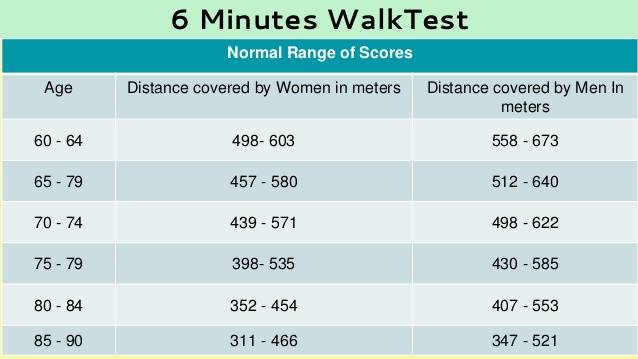Data:
04/07/2017
The original purpose of the 6 minutes walking test was to assess exercise tolerance in those affected by chronic respiratory disease and heart failure. It’s currently used to measure the functional capacity in other populations like elderly, special population such as pregnant women (http://www.hra.nhs.uk/news/research-summaries/the-six-minute-walk-test-in-pregnant-women-a-reference-range-study/ ), fibromyalgia, scleroderma, arthroplasty, and children as well (in particular obese ones).
The 6MWT was developed in 1963 by Balke, during this test, a person supposed to cover a target distance in6 minutes of walking without interruption, the individual is allowed to self-place and rest as needed as they travel back and forth along a marked walkway.
The theoretical cover distance might be estimated using a specific formula:
Male: 867-(5,71*age)+(1,03*stature)
Female: 525-(2,86*age)+(2,71*stature)-(BMI)

People unable to overcome 300 meters (0,660 miles), are considerate high risk of death, thus is considerate a reliable tool to estimate people hospitalization and mortality; it’s also used to detect changes following interventions to improve exercise tolerance for healthy older adults, as well as people with rheumatic conditions.
6MWT is administered in this way:
Due to the functional statues difference between participants, the 6MWT may cause a wide difference of performance between people; American Thoracic Society (ATS) provided detailed instruction that highlight how clients might become breathless or even worse, exhausted, thus this guidelines instruct them to take some rest during the test (for more information visit https://www.thoracic.org/statements/resources/pfet/sixminute.pdf ), then some articles instruct to walk as long as possible until six minutes; most important it’s have a reliable unit of measure to assess walked distance.
ATS recommend a 30 meters indoor corridor with coned placed at the starting and end point; studies conducted on stroke patients shown that a 30 meters length (versus 10 or 20 meters.) resulted in the longest distance covered and that treadmill might underestimate total distance covered. Encouragements are also a part of the protocol, although it varies in frequency across studies from providing encouragement every 30 seconds to every 2 minutes because it helps to rise total distance performed in 6 minutes.
6MWT is a cheaper test which require: 30 meters distance, cones or brightly colored tape to mark boundaries of the course, stopwatch, heart rate monitor, sphygmomanometer, and a chair in case the client require rest during the test. Heart rate monitor and sphygmomanometer are not necessary to fulfil this test, nonetheless, if we want to assess the Oxygen consumption of the heart, such as the functional capacity of the person, they become inevitable.
6MWT allows to estimate V02Max, better known like the maximal oxygen consumption or the capability to use oxygen during exercise or physical activity.
V02Max can be predicted using the following formula:
V02Max: (0,02* distance traveled)-(0,191*age)-(0,07*bodymass)+(0,09*stature)+(0,26*RPP*0,001)+2,45
Where distance traveled in express in meters, and RPP represent the rate pressure product, also referred to as double product.
RPP is the product of the heart rate (HR) and systolic blood pressure (SBP) and it serves as an estimate of the Myocardial Oxygen Demand (MV02), or the oxygen used from the heart during the activity.
RPP=HR*SBP

During resting conditions, heart consumes approximately 70% of the oxygen delivered to the cardiac muscle. During exercise, the cardiac muscle performs more work because of an increase of the HR and SBP as well; MVO2 increases during exercise in direct proportion to the exercise intensity.
A lower MV02 during high intensity exercise indicate an improvement of the cardiovascular fitness, so, even though sometimes V02Max value might not change, an increase of the distance traveled compared to a lower myocardial oxygen demand might be considerate a remarkable tool to realize if there’s an improvement of the overall cardiovascular fitness.
In conclusion, we might say that 6MWT compared to other cardiovascular fitness tests is considerate one of the better choice, compared to other tests, to estimate cardiovascular fitness in special population because takes into account more factors like HR, SBP, MV02, Distance covered etc.
6MWT may help operator to work in a safer and professional way to help special people accomplish their outcomes.
Bibliography
About the author:
Francesco Mucedola
ACSM Certified Exercise Physiologist
Training Lab Certified Personal Trainer
M.Sc. Adapted Physical Activity
B.Sc. Sport and exercise Science.
I MIGLIORI CORSI PER STUDENTI E LAUREATI IN SCIENZE MOTORIE
Scopri i prossimi corsi e scegli quello che fa per te!
I MIGLIORI CORSI PER STUDENTI E LAUREATI IN SCIENZE MOTORIE
Scopri i prossimi corsi e scegli quello che fa per te!
I MIGLIORI CORSI PER STUDENTI E LAUREATI IN SCIENZE MOTORIE
Scopri i prossimi corsi e scegli quello che fa per te!
Training Lab News
TRAINING LAB ITALIA - S.R.L.S.
P.IVA 02202690687
Richiedi il tuo codice sconto del 10% su tutti i nostri corsi.